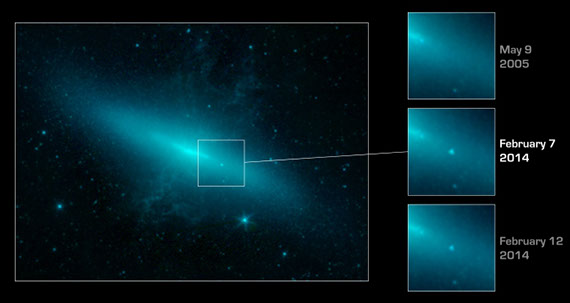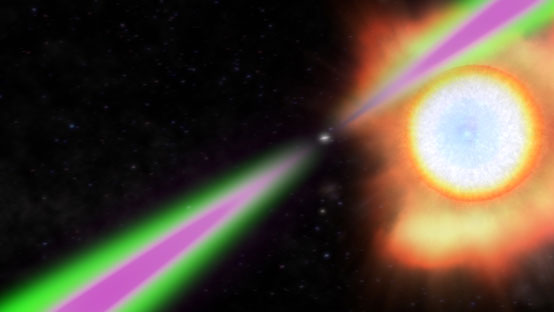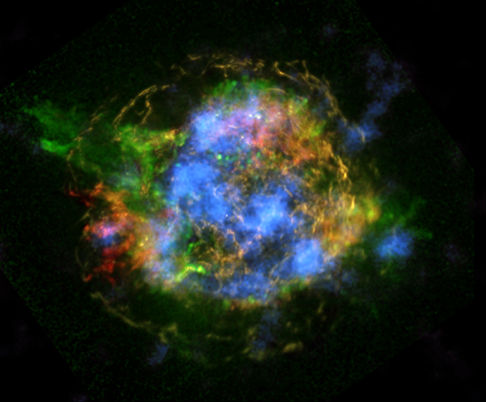



March 2014
Spitzer Studies Forming Planets
NASA's Spitzer space telescope has been observing planets being formed around distant stars. Around the star, gas and dust form a disk , which eventually forms the planets, comets, moons and asteroids in the new solar system. In the 1980's a mystery developed when it was discovered that the disk of gas and dust emitted more infrared light than expected. Many theories were put forth over the years but none could accurately account for the excess infrared light. Now, the Spitzer Infrared scope has unlocked the secrets.
It had previously been determined that the infrared light had to originate not only from the disk of gas and dust, but there must additionally be a halo of dust around the star. But even this did not account for the infrared light. Spitzer has been studying stars with planet forming disks and using 3D modeling has determined that there are giant loops of gas and dust suspended above the disks on gigantic magnetic loops. This is much like the magnetic atmosphere found on our sun where solar prominences can flare up in giant loops.
The new theory, based on these recent observations, proposes the infrared light comes from material not in a disk or halo, but in a disk atmosphere supported by magnetic fields.
Spitzer will continue analyzing planet forming stars and other observatories in space and on the ground will also be linked together as interferometers to continue the study.
Spitzer Studies Supernova SN 2014J
On January 21, a supernova blast was detected in the Cigar Galaxy, M82, located in Ursa Major. It is a rare opportunity to study a supernova explosion, so observatories around the world and in space aimed their instruments there. NASA's Spitzer Space Telescope was able to study the supernova in the infrared spectrum, peering through the dust.
Dust in the Cigar Galaxy obscures optical and high-energy forms of light, but Spitzer reads the infrared, thereby giving astronomers a clearer picture of what is going on in the supernova itself.
The supernova was named SN 2014J. It is a Type 1a supernova. A Type 1a supernova is a complete destruction of a white dwarf, the remains of a sun that has run out of fuel. All Type 1a supernovas explode with almost exactly the same amount of energy. They have near-uniform peak brightness. Because of this, they are considered the "standard candles"and allow astronomers to measure distances to nearby galaxies and the expansion of the universe itself. Studying SN 2014J will help determine and understand the processes involved.
SN 2014J is glowing very brightly in the infrared spectrum. Spitzer was able to study the supernova before and after SN 2014J reached its peak brightness. This is providing astronomers a rare opportunity to study a supernova in such depth. Using the data obtained in the infrared from Spitzer, along with data obtained by other space telescopes and ground based scopes from around the world, scientists will be able to learn a lot more about the mechanics and science of how these explosions occur.

PHOTO: NASA/JPL-CalTech/Carnegie Institution for Science
FOUND: 715 more planets
NASA's Kepler mission has found another 715 planets orbiting 305 other stars. This brings the confirmed count of planets outside our solar system to almost 1,700.
About 95% of the newly found planets are smaller than Neptune. Neptune is about four times the size of Earth. Four of these planets are less than 2.5 times the size of Earth and orbit in what is called the "habitable zone", the distance from the star that is not too cold nor too hot to have liquid water, which is required for life as we know it to exist.
Kepler observes 150,000 stars and has found a few thousand that are candidates for having planets. Kepler observed hundreds of these stars may contain multiple planets - a solar system not unlike ours. These new 715 confirmed planets were from data obtained by Kepler from May 2009 to March 2011.
In the next few years, NASA plans to launch the James Webb Space Telescope. With never before achieved resolution, the Webb scope will be able to look closer at these solar systems and study the makeup of these planets in finer detail.
UPDATE on Kepler spacecraft. In May 2013 the Kepler spacecraft lost use of a second reaction wheel. This meant that the spacecraft could not be aimed and stabilized to observe distant stars. It was thought the 4 year mission was over. But a new mission concept was developed, called the K2 mission. Kepler cannot be moved around, but it can still see stars in the ecliptic plane using its remaining two good reaction wheels. K2 will allow Kepler to continue observing, albeit in a smaller region of space. But even in that smaller region of space, there is much to explore and find. The K2 mission is awaiting funding, and in the meantime Kepler is being readied and tested in hopes the funding is approved.
Visit our sponsors.
For advertising opportunities on this page and our videos, contact
Upcoming Launches
Date: March 16
Launch Vehicle: Falcon 9
Launch Site: Cape Canaveral AFS, Florida - Complex 40
Description: Space-X will be the third commercial resupply mission to the International Space Station
Date: March 25
Launch Vehicle: Soyuz 38
Launch Site: Baikonur Cosmodrome, Kazakhstan
Description: Soyuz 38 will take Steve Swanson, Oleg Artemyev and Alexander Skvortsov to the International Space Station
Black Widow Pulsars
A Black Widow spider, and the Australian Redback spider, are known for eating their mates. Now astronomers have discovered cosmic black widows, pulsars that devour their mates.
What happens in a binary star system when one star is a normal low-mass star and the other forms into a neutron star? The neutron star becomes a pulsar and eventually destroys the normal star. Scientists have named these pulsars after the spiders, black widows and redbacks. So far, they have found 18 black widows, which are smaller and of much lower mass than a redback pulsar of which they have found 9 so far.
When a star explodes as a supernova, it forms a neutron star which has more mass than our sun but is smaller than a city. The neutron star begins to rotate at about thirty times a second sending off radio, light, X-rays and Gamma-rays. As the star rotates, it appears from Earth that the energy is pulsing, thus we call it a pulsar. Eventually, the pulsar will slow and fade away.
Scientists then discovered pulsars that were spinning much faster, up to 43,000 times a minute. These were called millisecond pulsars. More than half of them were part of a binary star system. But scientists never knew why some pulsars spun so fast. Now, the Fermi Gamma-ray space telescope is shedding light on the situation. It appears the neutron star is devouring its mate, and the energy in that process makes it spin faster and faster.
Studying the pulsar PSR J1311-3430, it was noted that one side of the normal star appeared blue and the other red. In astronomy, blue is hot and red cool. So the star had a hot side at near 21,000 degrees F and a cool side at 5,000 degrees F. The pulsar was heating one side of its companion star while the far side remained cooler. The pulsar was heating the companion star to a point where it was ionizing it. Eventually, over millions or billions of years, the companion star will be completely eradicated. As the ionization blocked a lot of the radio waves, Gamma-rays were not blocked, thus Fermi was able to measure the effects of the pulsar on the star.
It is suggested that the millisecond pulsars found without mates have already destroyed the companion.
The artist's concept below shows PSR J1311-3430 with its beams of radio (green) and Gamma-ray (red) heating one side of its companion star that it will eventually evaporate.

Image credit: NSA's Goddard Space Flight Center
How a Star Explodes
When a star reaches the end of its life, its Hydrogen used up, large stars explode in what we call a supernova. But why? And how? It has been one of the biggest mysteries in astronomy. But now, NASA's NuSTAR (Nuclear Spectroscopic Telescope Array) is unlocking the answers.
NuSTAR is a high-energy X-ray observatory and has been studying Cas A, a supernova remnant in the constellation Cassiopeia. The light from the explosion reached Earth only a few hundred years ago, so now we can see the stellar remnant from not long after the explosion itself.
When a massive star explodes as a supernova, light elements are fused together producing heavy elements such as gold and iron. NuSTAR is the first telescope that can map the radioactive elements in a supernova remnant. NuSTAR has mapped titanium-44 in Cas A.
Computer simulations have always shown that the shock wave created when a massive star collapses will stall out and the star will not explode. But the star does in fact explode, so scientist have been left with a great mystery. By looking at the titanium-44, NuSTAR has shown that the element has an unstable nucleus and is produced at the heart of the star. The star is literally sloshed around inside. This causes the stalled shock wave to re-energize and finally cause the star to explode.
Other models of a supernova suggest the star starts rotating rapidly and shoots jets of narrow streams of gas that cause the explosion. But the NuSTAR data contradicts this theory. NuSTAR found no titanium in the radioactive remnant in narrow regions matching the jets, thus the jets did not trigger the explosion.

Map of Cas A. Radioactive material is shown in blue.
Credit: NASA/CalTech/CXC/SAO
Carbon Monoxide Mystery Cloud
A large cloud of carbon monoxide gas has been found around the star Beta Pictoris. The discovery was made by the Atacama Millimeter/submillimeter Array (ALMA) in Chile. Beta Pictoris is in the southern hemisphere constellation of Pictor.
What makes this cloud such a mystery is that carbon monoxide is usually destroyed by starlight. So something is making the cloud replenish itself. Carbon monoxide is given off when icy objects such as comets collide. This could explain the cloud. But for the cloud to be as large as it is, there would have to be a vast number of comets colliding at a rate of a collision very five minutes. To concentrate that many comets in only place would require a gravity source from a planet about the size of Saturn. A planet that size has not yet been detected but certainly could exist.
Another possibility is that the cloud was created in a collision of two icy objects each the size of Mars.
The gas is concentrated in a single clump about 13 billion kilometers from Beta Pictoris. This is about three times the distance from our sun to Neptune. Why the gas is so far away from the star is another mystery.
Beta Pictoris is a young, just forming solar system. It has one known planet in an orbit of 1.2 billion kilometers from it. The star is surrounded by a disk of dusty debris. Comet bombardment would be common at this time in its history and carbon monoxide indicates that it could someday become a good habitat for life. Comets contain carbon monoxide, carbon dioxide, ammonia and methane, but the major component of comets is a mix of dust and water ice.

Credit: ALMA (ESO/NAOJ/NRAO) and NASA Goddard Space Flight Center/F. Reddy
© 2014-2016 Ted Cook Productions LLC. - All Rights Reserved